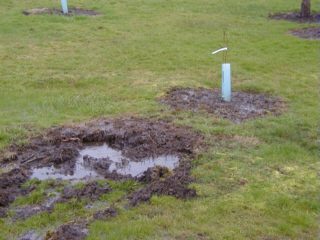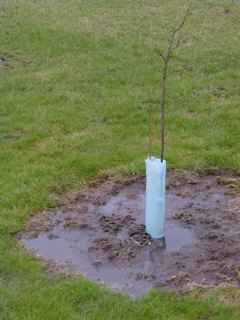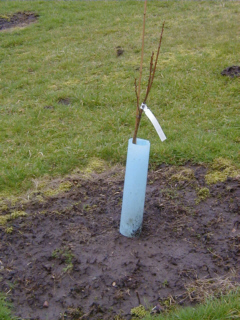| |
Chestnut Trees in Wet Soils
According to serveral chestnut exprerts, chestnut trees will not tollerate
wet ground. There is also a limit to how much clay the soil can be
composed of. Here we will examine several examples of chestnut trees in
different growing conditions. When considering a location for establishing
a chestnut orchard, check the soil conditions. Here in Northwest Washington state
the chestnut trees are stressed with excessive moisture during the fall,
winter and spring. Then during the summer the soil drys out to the point where
young trees will not survive without irrigation.
What the Backyard Grower Say
When it comes to soil types the most often quoted soil type for growing
chestnut trees is "sandy loam". Let's make one thing clear, almost every
commercial crop grown grows best in sandy loam soil. On the "it won't grow
in that soil" list is clay. Not all clay is the same. Some clays drain
water freely while some clays would make a great basin for a swimming pool.
What the Experts Say
Experts in plant pathology consistantly say "Chestnuts will not
grow in clay soil." There are two important characteristics of clay soil,
permiability (the ability of water to pass through) and pH that
will determine if a chestnut tree will survive. According to
Jeff Olsen, Oregon State University Extension Horticulturist,
"..the recommended soil pH for chestnut orchards is between 5.0
and 6.0..." (Western Chestnut 2003 Winter). For many places in
the United States soil pH is often over 6.0. In the Pacific
Northwest soils west of the Cascade mountians are usually between
5.0 and 6.5. In soils where the pH lower than 5.5 the nutrients
become very soluble and are readily leached from the soil.
When considering a location for a chestnut orchard
the soil pH must the checked before any other planning is done. The
pH can be adjusted using soil amendments. Contact your local
ag extention office for help with adjusting soil pH.
Soil is the part of the lithosphere where plants grow.
Soil composition is described as "fine mineral particals, air,
water, dead organic matter, and various types of living organisms".
All of these parts of the soil are very important for growing
chestnuts. To much or to little water and chestnut trees die.
Not enough air in the soil causes lower levels of biological
and chemical ativity. Clay soils both shed water and hold water.
The finer mineral particals in clay have greater surface area
providing a greater capicity for holding water. If the mineral
particals are to small, the particals adhear to each other so
tightly that water can not pass through.
Soil partical size is not standard within soil. Most soils are
composed of various partical sizes. Rocks and pebbels are
particals larger than 2.0 mm. Sand particals are between 0.06 mm and
2.0 mm. Silt particals are between 0.002 mm and 0.06 mm. Clay is
where particals are less than 0.002 mm. The large surface area of
clay is highly reactive and has the ability to attract and hold
positively charged nutrients. These nutrients are normally available
to plant roots for nutrition as long as the pH is not to low or to high.
Examples with Discussions

|
Here is an example of a soil saturated with water to the point that water
is present in the hole. This soil is too wet for most types of chestnut trees.
The nearby chestnut tree with the blue plastic protector has died. The tree
at the top of the picture is doing just fine 28 feet away. The small
hole in this picture was created when a smarll pine tree that had been
blown over by a wind storm was pulled out of the ground.
During the summer this spot will remain moist up until late July. The soil
has a high level a clay which helps it remain moist in the summer but during
the fall and in the winter it is just too wet for most types of chestnut trees.
|
This chestnut tree is sitting in nearly the same soil as the one pictured above
and it is still alive. Why? The water may drain faster in this area as
compared to where the pine tree was growing. It will likely die at some
time in the future because of the standing water. The water is present in
the dormant season and not during the growing season. The chestnut plant
pathologists warn that the presents of the water for extended periods
of time (several weeks maybe too long) provides pathogens opportunity to
attach the chestnut tree root system.
Plant pathologist Dr. Dennis Fulbright is an expert with chestnut pathogens.
His research has suggested that chestnut trees must be in well drained soil.
When water is present for extended periods ethanol becomes present around the
root system. Once present, the environment around the roots becomes well
adapted for the propagation of phytophthora, a known chestnut tree killer
pathogen.
|

|

|
When the conditions are just right a chestnut tree will grow and become
fruitfull. Site location is the starting point. The chestnut tree in
this picture is in well drained soil. The soil classification is close
to what is consdered "sandy loam soil". The difference between this soil
and true sandy loam soil is the amount of clay present. Looking at the
base of the tree pebbles can be seen. The soil has a lot of this size
pebbles/rocks present. It also has a high consitration of smaller
sand and silt particles.
The soil never has water sitting on the surface even after a heavy rain.
This chestnut tree is 2 years old. It was planted in the spring of 2006 as a
seedling.
During the first growing season this tree grew a little over a foot. A
chestnut tree when young will grow anywhere from just a few inches to over
4 feet in a single growing season.
|
Some Advice for New Growers
The best advise for those trying to start a
comercial chestnut orchard is:
1. Check your soils with soil analysis
2. In early August have a leaf analysis performed
3. Don't let the soil dry out during the first growing season for new trees
4. Don't overwater during the growing season - this will kill trees
5. The experts say "Don't fertilize the first year." If your soil has
deficiencies, correct them with fertilizer as soon as they are discovered
6. If you want nut production quick, don't prune your trees
7. If you want a health strong orchard prune whenever needed
8. There is no standards for growing chestnuts - your a pioneer, do
your best and pray over the rest
|
|



